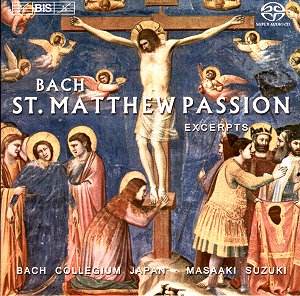
J.S. BACH
(1685-1750)
St. Matthew Passion - excerpts
(Part One): 1 1 Kommt, ihr Töchter chorus [8:01], 2 8 Blute nur aria
(soprano) [4:44] 3 18 Da kam Jesus recitative (Evangelist,
Jesus) [1:52] 4 20 Ich will bei meinem Jesu wachen, aria
(Tenor) [4:44] 5 26 Und er kam und fand sie recitative
(Evangelist. Jesus, Judas) [2:31] 6 27A So ist mein Jesus,
aria (soprano, alto) [4:55] 27B Sind Blitze.sind Donner chorus
7 29 O Mensch, bewein dein Sunde groß chorale [5:55]
(Part Two): 8
30 Ach! nun ist mein Jesus hin! aria(alto) [3:37] 9
36A Und der Hohepriester antwortete recitative (Evangelist,Pontifex,Jesus)
[2:02] 36B Er ist des Todes schuldig! Chorus, 36C Da spieten sie
aus recitative (Evalgelist) 36D Weissage uns, Christe chorus
10 39 Erbarme dich aria(alto) [6:08] 11 45A Aber
die Hohenpriester recitative(part Evangelist,Piatus) [1:02] 45B
Laß ihn kreuzigen! chorus, 12 46 Wie wunderbarlich ist doch
diese Strafe! chorale [0’38], 13 49 Aus Liebe,aus Liebe
aria (soprano) [5:23], 14 50A Sie schrieen aber noch mehr
recitative(Evangelist) [1:48], 50B Laß ihn kreuzigen! Chorus
50C Da aber Pilatus sahe recitative (Evangelist,.Pilatus)
50D Sein Blut komme über uns chorus 50E Da grab er ihnen Barrabam
los recitative (Evangelist) 15 52 Konnen Tranen meiner Wangen
aria (alto) [5:40], 16 53A Da nahmen die Kriegsknechte recitative(Evangelist)
[1:11] 53B Gegrüßet seist du, judenkönig! chorus, 53C Und speieten
ihn an recitative(Evangelist), 17 54 O Haupt voll Blut und
Wunden chorale[1:57]. 18 58A Und oben zu seinen Haupten
hefeten recitative[part] (Evangelist) [2:10] 58B Der du den Tempel
Gottes zerbrichst chorus, 58C Desgleichen auch die Hohenpriester
recitative (Evangelist) 53D Andern hat er geholfen chorus,
19 60 Sehet, Jesus hat die Hand aria (alto)[ 2:58, 20
61A Und von der sechsten Stunde an recitative (Evangelist,
Jesus) [2:31] 61B Der rufet dem Elias! chorus, 61C Und bald
lief einer unter ihnen recitative (Evangelist) 61D Halt! Laß sehen
chorus,61E Aber Jesus schriee recitative (Evangelist) 21
62 Wenn ich einmal soll scheiden choral [1:25], 22 63A Und
siehe da recitative (Evangelist [1:34] 63B Wahrlich,dieser ist
Gottes Sohn gewesen chorus 23 67 Nun ist der Herr zu Ruh
gebracht recitative( bass, tenor,alto,soprano) [1:50], 24 68
Wir setzen uns mit Tränen neider chorus [5:27]
![]() Nancy Argenta, soprano
Nancy Argenta, soprano
Robin Blaze, counter-tenor
Makoto Sakurada, tenor
Gerd Türk, bass
Peter Kooij, bass
Chiyuki Urano, bass
Bach Collegium Japan/Masaaki
Suzuki
Recorded in March 1999 at the Kobe Shoin Womens’s University, Japan
![]() BIS BIS-SACD-1500
BIS BIS-SACD-1500 ![]() [81:18]
[81:18]
BUY NOW
AmazonUK AmazonUS






